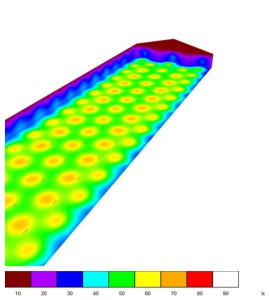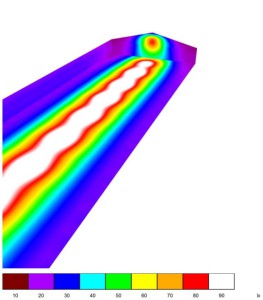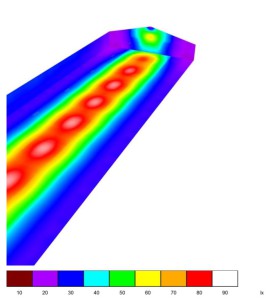High-quality lighting – the key to success!
Equal destribution of light in the poultry house.
High-quality lighting in livestock buildings creates the conditions for a stress-free cultivation. Under the light quality a set of parameters is meant: The equal destribution of illumination, matching levels of illumination to standard values, the possibility of brightness reducing, smooth turning on and off of lamps
Equal distribution of light in the house significantly affects many growing indicators: weight gain, feed conversion, egg production and cannibalism
If chickens kept indoors since the first week of life, it is very important that all the lines were watering and feeding well lit and the chicks can easily find water and food. When it is dark in the early days may adversely affect the further growth indicators: Conversion and weight gain
At the content of parent stock floor should not be places with low light or with shadows. The entire space, except the connectors, should be illuminated brightly and evenly. Otherwise, possible egg laying on the floor in places not well lightened.
Lighting in the house must necessarily be dimmed. With high brightness the bird can be aggressive, which will result cannibalism.
This article will take a look at how to achieve an equal distribution of light throughout the room.
The main factor for the achievement of the result is the use of low power lamps with a minimum distance between them. For different levels of illumination is necessary to use different power lamps. Power also depends on the size of the house and the height of the lighting lifting. Many years of experience in the supplying of LED lighting to the poultry farms has shown that the best results are obtained with lamps ranging from 5W to 15W. The following table shows the recommended power of LED lamps for different light levels and different lifting height.
| Bird type, light level |
laying hens, 10-30 |
broiler, lux 30-60 |
Rearing, parents, 70-80 lux |
| Lifting height from 2m to 3.5m | 5 W | 10W | 10W / 15W |
| Lifting height from 3.5m to 6m | 10W | 10W / 15W | 15W |
Sometimes lights in poultry houses are placed in a line in the apex of the building (5-6m), counting on a uniform illumination by the suspension height. It uses the lamp power 75W, 100W or more. For example, consider three options for the lighting of a typical building size of 100m x 21m with an average illuminance on the floor 50lk and perform calculations for them:
- version №1: LED lighting power of 10W for 5 lines with the lifting at a height of 3m, the direction of the luminous flux – down
- version №2 : LED lighting power of 75W for 1 line with the lifting at a height of 6m, the direction of the luminous flux – down
- version №3: LED lighting power of 75W for 1 line with the lifting at a height of 6m, the LEDs are turned on by the vertical angles of ±60 degrees in the direction of walls
Calculations demonstrates that in order to achieve the equal destribution of illumination in livestock buildings is not permissible to use a single line of lamps, even when lines placed higher. Use only low-power lamps on several lines.
Along with poor light destribution, the use of LED lamps with 75 W and more has a few other disadvantages
- At a height of 5-6m difficult to clean the glass of lamps from dust and dirt
- powerful lamps have a radiator to dissipate heat, and washing any dirt and lint out of it at the height of 5-6m is an extremely difficult task; If dirt is not removed, the heat dissipation is worsen and lifetime of the lamp is dramatically reduced
- high voltage (typically 230V AC) and the hot glass will not allow to complete the washing while making it with a hand lamp on is quite dangerous.
- disconnection or failure of one lamp will lead to darkening of a large area on the floor



